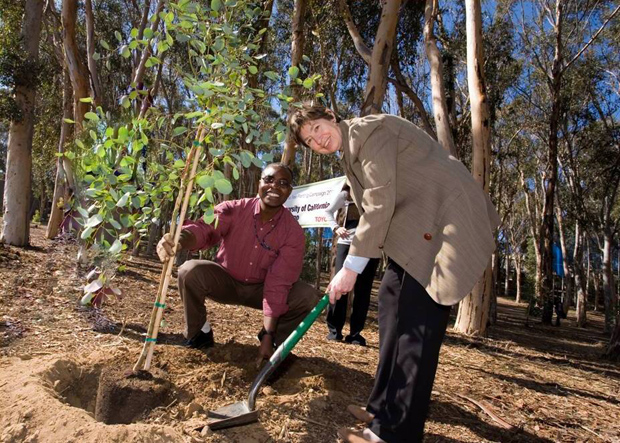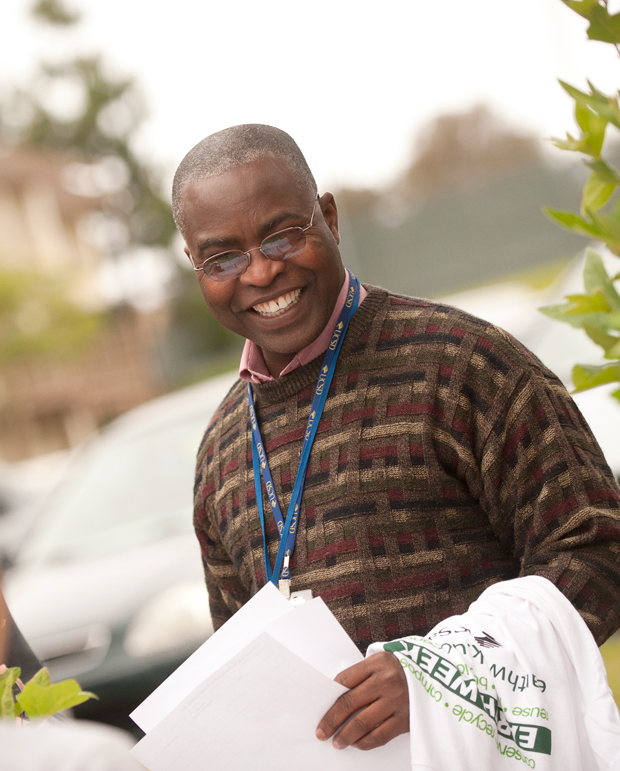
By:
- Paul K. Mueller
Published Date
By:
- Paul K. Mueller
Share This:
UCSD's Campus Forester Explains 'Prospects, Process and Profits' of Urban Forestry at National Conference

Samuel Oludunfe, UC San Diego's urban forester, is well known for his work on campus. His achievements have been featured in This Week @ UC San Diego as well as in other university publications. He recently took his expertise to a national conference of foresters in Florida, where he spoke on the "Prospects, Process and Profits of Campus Urban Forestry: The UC San Diego Story" to a gathering of his peers.
Campus-grounds managers, landscape architects, facilities directors and other attendees at the Tree Campus Canopy Summit discussed the changing and often-challenging jobs of tree maintenance and preservation; campus and community collaborations; and the Tree Campus USA national recognition program.
Oludunfe's message was based on experience: A sound Urban Forest Management Plan helps campuses forge partnerships, build enduring bridges, and strengthen the fabric between campus and community, he told those attending the conference.
Partnerships must involve offices and departments across campus, he said, from Facilities Management to Housing & Dining to Sports Facilities and others. Enduring bridges to faculty, staff and students can be built using promotional publications, campus events, and community forestry programs and discussions. To help strengthen the bonds between campus and community, foresters must recognize opinion leaders, identify and cultivate potential donors; encourage participation; and establish a wide base of volunteers.

Samuel Oludunfe
At the heart of a useful urban-forest management plan, Oludunfe says, are four straightforward questions: What do we have? What do we want? What do we need? How do we get what we want? The goal is to maintain a campus that preserves our ecological heritage and that is a desirable place to work, learn and live.
The campus forest includes more than 230,000 trees on about 130 acres, Oludunfe says. Although no formal inventory has been made, about 90 percent of them are eucalyptus, in a 112-acre grove dating to the early 20th century. The eucalyptus trees are a defining element of UC San Diego. The remaining 10 percent are a mix of more than 100 species, including palms and evergreens. A recent study calculated the value of the ecosystem “services” provided by the campus forest at $2.7 million each year, which foresters hope to preserve and enhance with the continual addition of new trees.
Trees are important to human health, the forester says. One hundred trees remove five tons of carbon dioxide per year, and about 1,000 pounds of pollutants a year, including 400 pounds of ozone and 300 pounds of particulates. At UC San Diego, our 230,000 trees remove 64,400 tons of carbon dioxide and 1.38 million pounds of pollutants from the atmosphere every year, says Oludunfe.
Using the right trees in the right places also has quantifiable benefits, he says. Well-planned trees can save up to 34 percent of annual air-conditioning costs; make parking lots three degrees cooler in the summer months; reduce the interior temperatures of parked cars by 30 degrees; and save 10 to 25 percent of winter heating costs.
UC San Diego’s dedication to campus forestry management and environmental stewardship was cited by the National Arbor Day Foundation in naming the campus a “Tree Campus USA University” for three consecutive years.
"Reduced liability, value-added and enhanced safety, increased aesthetics, and secure environmental sustainability are all benefits of our campus forest," Oludunfe says. "A healthy forest is a beautiful thing -- and a joy for now as well as for posterity."
Share This:
You May Also Like
Stay in the Know
Keep up with all the latest from UC San Diego. Subscribe to the newsletter today.


